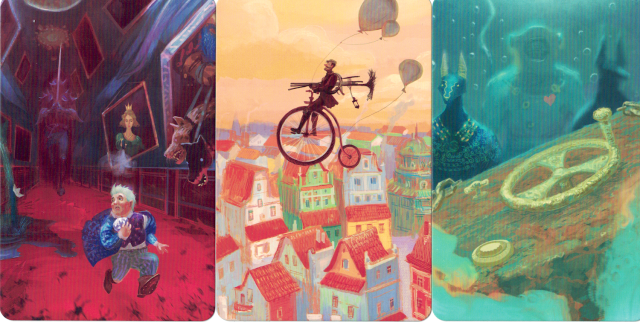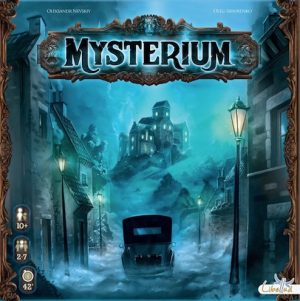
As I tramped the sodden sidewalks of Chicago beside my three-year-old son, holding his plastic pumpkin while he hiked up to door after door for handouts of candy, I had trouble focusing on the costumed Halloween mayhem all around me. Instead, I kept thinking about the group of psychic adventurers who would join me later that evening for our first-ever round of Mysterium, the gorgeous, ghost-driven Ukrainian board game finally out in an English version.
Set in a Scottish castle on Halloween night, 1922, Mysterium is an asymmetrical cooperative game that mixes elements of Clue and Dixit. In it, a ghost—who can "speak" only through dreamlike visions of horror and wonder—provides clues about his murderer to the gathered psychic investigators. The clues are delivered in the form of 84 "vision cards" that depict scenes of dimly glimpsed wolves, terrible scarecrows, an oversized knight chopping at a tower, a man running in terror down endless hallways, or a couple climbing into the mouth of a fish. The astonishing artwork feels like a dream, disquieting and surreal, and a quick flip through the deck was enough to convince me that I had found the perfect title for some Halloween fun with my gaming group.
Mysterium absolutely drips theme. It comes with an enormous cardboard screen that hides the ghost's activities, a cardboard clock to track the progress of the game's single night of play, a crystal ball token for each player, and even a downloadable soundtrack (.zipped MP3 file). Mysterium was not designed as a brain-busting strategy exercise but as a group experience.
And as an experience, it delivers in spades.

From Ukraine with love
Mysterium began life as a 2013 Ukrainian game called Містеріум. A Polish version, Tajemnicze Domostwo, drew a wider fanbase in 2014 after the manual was translated into English by fans. French publisher Libellud then acquired English rights and retooled the experience. The vision cards, the heart of the game, retain their original Ukrainian art, but Libellud tweaked the rules and the game presentation to accelerate play time; while Tajemnicze Domostwo could take 90 minutes, Mysterium's box now claims a remarkably specific 42-minute play time. (To read more about the changes in the English version, see the publisher's exhaustive description of the development process.)
Mysterium was finally made available to the US market in late 2015—just in time for play on Halloween night, when the game's story takes place.
To solve the mystery of who killed the ghost, the gathered psychics each have to identify a suspect, then a location, and finally a possible murder weapon based on visions sent by the ghost. If they can all do so before the night ends, the ghost sends one final vision to the group, naming the actual murderer, location, and weapon from among their gathered choices. The psychics vote; if a majority is correct, they all win. If incorrect, they lose.

Once the clues are distributed to the psychics, the ghost turns a two-minute sand timer. The psychics parse their clues, working together to discuss their meanings. The ghost player, back behind the screen, usually begins pulling hair out as player after player misreads the cryptic clues. Each player then sets a colored crystal ball token on their item of choice, and the ghost announces which psychics were correct. Those who guess correctly advance from people to places to weapons, while those who guess wrong remain where they are in the hopes that the next round's vision will bring more clarity.
If all players complete their sets of three clues before the clock strikes eight, each set is laid out on the table and numbered. The ghost chooses one numbered set as the correct one and selects three final vision cards to depict it. Thanks to a "clairvoyance" mechanic—essentially, betting on other players' guesses throughout the game—each player may see a different number of these final cards before having to make a decision. During this final phase, players can no longer cooperate and must vote silently on what the final vision represents.
Finally, the votes are tallied and the true murderer is revealed. The ghost is either released to an afterlife of peace or is doomed to haunt the gloomy Scotch manor for another year, until the next Halloween night brings the worlds of the living and the dead close enough once more that visions can be sent across the great divide.
A ghostly experience
The best way to play Mysterium is to soak yourself in its Gothic ambience, so for my first playthrough I mixed up hot toddies for my game group, put on my best Scottish cap, and lit some candles. With the soundtrack playing in the background, the theme felt perfectly realized—about as far as one can get from a title like, say, Castles of Burgundy, where players may justifiably feel that the only "theme" comes from an image database of bad French landscape paintings.

Even though no one had played before, setup was quick and play kept moving. Teaching time is minimal, and actual play time takes two minutes per round—regardless of the player count. The one bit of the game that can slow it down is the ghost's clue selection phase, which takes longer as more players join. But the cooperative nature of the game mitigates the delays; players can spend the wait time looking at other people's vision cards and talking about possible meanings.
Though targeted at more mature gamers, this is one that even kids can enjoy—though do use discretion with very small children or those with extra sensitivity to discomfiting images. My own girls loved Mysterium after joining us for the Halloween playthrough.
"It was creepy, but it was the best thing in the world," my six-year-old said.
My eight-year-old added, "If you want the sort of creepy feel, it's best to play at night. Totally awesome on Halloween night."
But, after a later run as the ghost, she cautioned that "whoever's going to be the ghost needs experience with the game and should be a little older—grownups or teenagers." It's true: picking helpful clues from a stack of vision cards can sometimes feel like shooting arrows into the dark, and the poor ghost is likely to frustrate herself and the psychics.
One other comment my older daughter made stuck with me. When I asked her ultimate verdict on the game, she said: "Fun. It's not awesome, it's okay. It's not like, 'I wish I could just open the lid and start playing.'"
While I would argue that Mysterium is indeed awesome (and several critics are already pondering it as a 2015 game-of-the-year contender), I think my daughter was on to something.
Several subsequent playthroughs confirmed that Mysterium is a terrific game, though for me not likely to be a title that gets pulled out on a daily or even weekly basis. Mysterium is not a tight, taut game like Splendor, where rules feel exact and inevitable. Instead, it's about feeling your way through ethereal images and hazy clues, picking up on colors or tiny images or motifs about traveling or visions containing water. Winning feels less important in Mysterium than it does in many other games, even in other co-op titles like Pandemic or Forbidden Island, where one races against a virus or a sinking island. A Mysterium loss means only that one waits another year to aid a ghost who has waited 30 years for justice already—and who is unrelated to the players. Less is at stake.
The game remains one well worth experiencing. It's the kind of game you'll pull out for friends and family who are not even into board gaming as a way of showing them the kind of experience that cardboard and tabletops can offer. And it's something that, after playing, you'll also want to share with your gaming group. But Mysterium may not be a title that will hit the table week after week with the same group of players. And that's perfectly fine.
The new edition remains a real achievement in game design, mixing up the older mechanics of a game like Clue with the dreamworld of something like Dixit, producing something truly novel. It's the kind of game every board gamer, even those who can't bring themselves to play anything less complex than Twilight Imperium 3, should try at least once.
reader comments
24